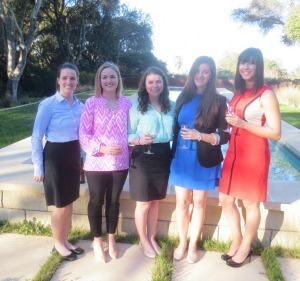Lucy Driscoll became interested in medical devices during her senior year at Notre Dame, where she graduated in 2013 with a degree in mechanical engineering. She joined the ESTEEM Class of 2014, where she works with mentor Diane Wagner, an Associate Professional Specialist in Aerospace and Mechanical Engineering, on a strategy to strengthen joint cartilage and relieve arthritis pain.
“ESTEEM just seemed perfect,” she says. “I didn’t even imagine the things I would learn this year – growing as a future employee, discovering what my strengths are. We’ve learned how to design our technical skills for business applications. I feel like we’re being given a really powerful skill set.”

The set builds on her technical training – Driscoll took two graduate-level mechanical engineering courses – and adds business expertise, an important combination for advancing discovery and invention.
“Engineers don’t know how to sell; entrepreneurs don’t have technical skills,” Driscoll says. “All of our business courses are geared toward technical applications – accounting, finance, everything we’ve learned is geared toward technical ventures. We’ve also taken an ethics class and a patent law class along with all the ESTEEM courses we’re required to take.”
For her program-long capstone project, Driscoll collaborates with Wagner, who investigates the effect of cross-linking on the mechanical properties of cartilage. Cross-linking involves placing an initiator on the cartilage, then zapping it with a laser to create more internal bonds that make the cartilage stiffer and more wear-resistant.
“This would aid arthritis patients whose cartilage is wearing down until it’s just bone on bone,” Driscoll says. “It’s in the really early phases of development. She’s been looking into the changes in mechanical properties of cow specimens of cartilage. The cartilage in joints is really special and unlike most cartilage in the body in that allows for smooth movement on its own.” Damage that impedes blood flow can keep the cartilage from regenerating.
“Once there’s damage, it’s sort of a slippery slope from there,” Driscoll says. “This technology would reverse the degradation process or at least slow it down or stop it. It was my job to design the application, so we came up with an arthroscopic treatment that you could apply after a reparative surgery. There would be this tool that quickly can apply the cross-linking treatment that would increase the wear resistance of the cartilage so the patient doesn’t develop arthritis more.”
She presented the business plan to venture capitalists and entrepreneurs during ESTEEM’s Spring Break visit to Silicon Valley. “It was a nice practice to pitch to people in Silicon Valley because they gave us feedback,” Driscoll says. “It was interesting to hear what they actually thought of the technology and whether it could actually be commercialized or not and whether we were going after the right market. We need to make sure that the technology is actually applicable and we go about it the right way.”
The research is in its early stages, and the application is probably a decade away, she says. Driscoll, who plans to return to her native Boston and find work in an engineering firm to boost her experience, expects to keep in touch with Wagner as the idea progresses.